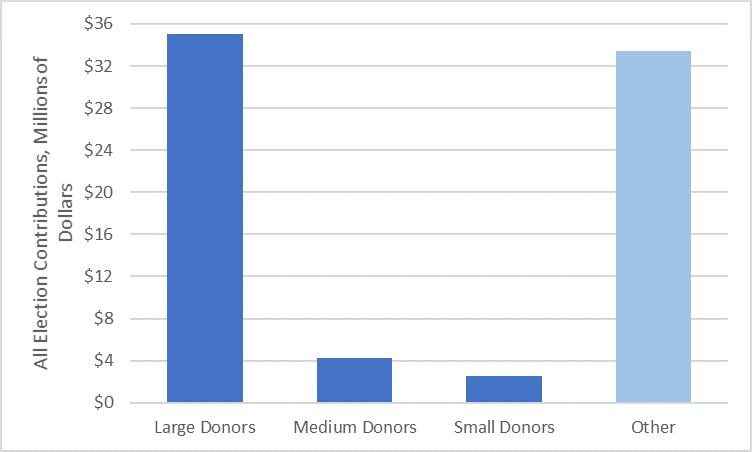
New Report: Big Money in Oregon State Elections
The dominating influence of large political donors shapes elections from beginning to end – from an individual’s decision to run for office, to a candidate’s ability to get his or her message out to the public, to the makeup of the people with whom a candidate spends time while running for and serving in office.

The dominating influence of large political donors shapes elections from beginning to end – from an individual’s decision to run for office, to a candidate’s ability to get his or her message out to the public, to the makeup of the people with whom a candidate spends time while running for and serving in office.
Our new report with OSPIRG Foundation, Big Money in Oregon State Elections: The Need to Restore Balance to Democracy by Empowering Small Donors, looks at the role large donors played in Oregon’s 2016 state-level elections.
Our review of campaign finance data found that just 723 large donors outgave the more than 31,000 small donors to candidate and ballot campaigns by nearly 14 to 1 – overwhelming the voices of regular Oregonians in candidate and ballot measure races.
In 2016, just 723 large individual and business donors (those giving $5,000 or more) collectively contributed $34.9 million to Oregon candidate and ballot measure campaigns. In contrast, more than 31,100 small donors (those giving $250 or less) collectively contributed just $2.5 million; it would have taken almost 270,500 small donors – 1 out of every 15 Oregonians – making the average contribution to match the amount of money coming from those 723 large donors.
Figure 1. Campaign Contributions by Donor Size/Type in Oregon 2016 State Elections*

*“Other” accounts for giving by organizations and groups that may be used either to channel individual large contributions to candidates or to aggregate contributions from many smaller donors, such as non-profit organizations or political action committees.
Disparities between small and large donors exist in both candidate and ballot measure campaigns. Large donors to candidate campaigns gave 3.7 times as much in total as small donors, while large donors to ballot measure campaigns outgave small donors by a ratio of 190 to 1.
But perhaps most troubling is the way in which the dominance of large contributions in campaigns makes access to big-money donors a key criterion for success, potentially discouraging Oregonians with an interest in public service from competing for office. Potential and previous candidates for local, regional or state office shared their experiences with us:
- Ozzie Gonzalez has considered running for multiple local offices, including most recently that of Metro Council President: “One of the first advisors I reached out to … immediately said, ‘The first thing you need to do is start a PAC. You’ve got to get a good fundraising agency.’ It shifted my perspective so quickly. … When I realized you have to set up a PAC, a fundraising mechanism, find a fundraising partner, and you’ve got to quit your job to focus on reaching out to the key donors that are going to get your political campaign off the ground … it dissuaded me altogether.”
- Moses Ross ran for a seat on the Portland Community College Board of Directors: “The only way you’re going to be able to make a strong impact is through mass communication. And that meant phones, mail, canvassing. And I didn’t have the money for the ground game. That was the challenge.”
- Jamila Singleton ran for a seat on the Portland Board of Public Education: “The fundraising part was really challenging. … I probably spent only 5 percent of my time canvassing, compared to 80 percent of my time fundraising.”
However, Oregon can restore balance to its elections by adopting a policy proven to amplify the voice of small donors in elections – matching small contributions with public funds. Some cities, counties and states have already implemented programs such as this, including New York City.
Had Oregon had a small donor matching program in place for the 2016 elections, with a 6-to-1 match on contributions from in-state donors of $250 per candidate or less, the dominance of large donors would have been significantly curtailed. Instead of large donors outgiving small donors to candidate campaigns by a ratio of 3.7 to 1, funding from small donors and small donor-related matching funds would have exceeded contributions from large donors by $4.1 million.

Oregon’s elections are no exception to the influence big donors have over U.S. political elections. Small donor programs provide campaign finance reform models that enhance the voice of all voters, regardless of the size of their wallets.
Authors
R.J. Cross
Policy Analyst, Frontier Group
R.J. focuses on data privacy issues and the commercialization of personal data in the digital age. Her work ranges from consumer harms like scams and data breaches, to manipulative targeted advertising, to keeping kids safe online. In her work at Frontier Group, she has authored research reports on government transparency, predatory auto lending and consumer debt. Her work has appeared in WIRED magazine, CBS Mornings and USA Today, among other outlets. When she’s not protecting the public interest, she is an avid reader, fiction writer and birder.
Find Out More

Engaging with government, even as we’re physically distant

A Midterm Lay of the Land: Democracy

Away from the Partisan Sound and Fury, a Transpartisan Reality

